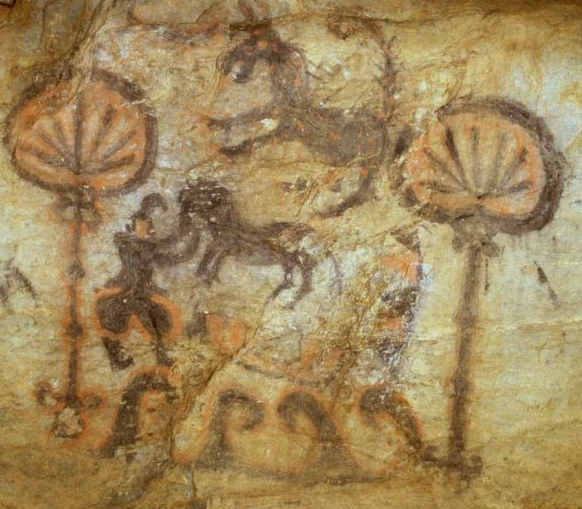|
Decorated Kofun
is the term used for kofun or ancient Japanese tombs ornamented with Japanese painting, painted or Japanese sculpture, carved decoration. The tombs take the form of tumuli or earthen mounds piled over stone chambers as well as caves excavated from the living rock. The decoration may be on the inner walls, on stone screens, on sarcophagi or, in the case of cave tombs, around the entrance on the exterior. Of the 161,560 ancient burials identified to date, around two hundred and fifty are so decorated."Japanese terms: ; ; ; ; ; Motifs Decorative Motif (visual arts), motifs include the ''chokkomon'' (an X-shape forming triangular zones that intersect irregular curves), circles, concentric circles, triangles, human figures, horses, birds, boats, swords, shields, and quivers.Japanese terms: ; ; ; ; ; List of decorated kofun This list is of the decorated kofun of ancient Japan, all of which are located in Fukuoka Prefecture, Fukuoka prefecture. See also * Kofun period * Takamatsuzu ... [...More Info...] [...Related Items...] OR: [Wikipedia] [Google] [Baidu] |
Kofun
are megalithic tombs or tumuli in Northeast Asia. ''Kofun'' were mainly constructed in the Japanese archipelago between the middle of the 3rd century to the early 7th century CE.岡田裕之「前方後円墳」『日本古代史大辞典』大和書房、2006年。 The term is the origin of the name of the Kofun period, which indicates the middle 3rd century to early–middle 6th century. Many ''kofun'' have distinctive keyhole-shaped mounds (). The Mozu- Furuichi kofungun or tumulus clusters were inscribed on the UNESCO World Heritage List in 2019, while Ishibutai Kofun is one of a number in Asuka-Fujiwara residing on the Tentative List. Overview The ''kofun tumuli'' have assumed various shapes throughout history. The most common type of ''kofun'' is known as a , which is shaped like a keyhole, having one square end and one circular end, when viewed from above. There are also circular-type (), "two conjoined rectangles" typed (), and square-type () kofun. Orientation ... [...More Info...] [...Related Items...] OR: [Wikipedia] [Google] [Baidu] |

